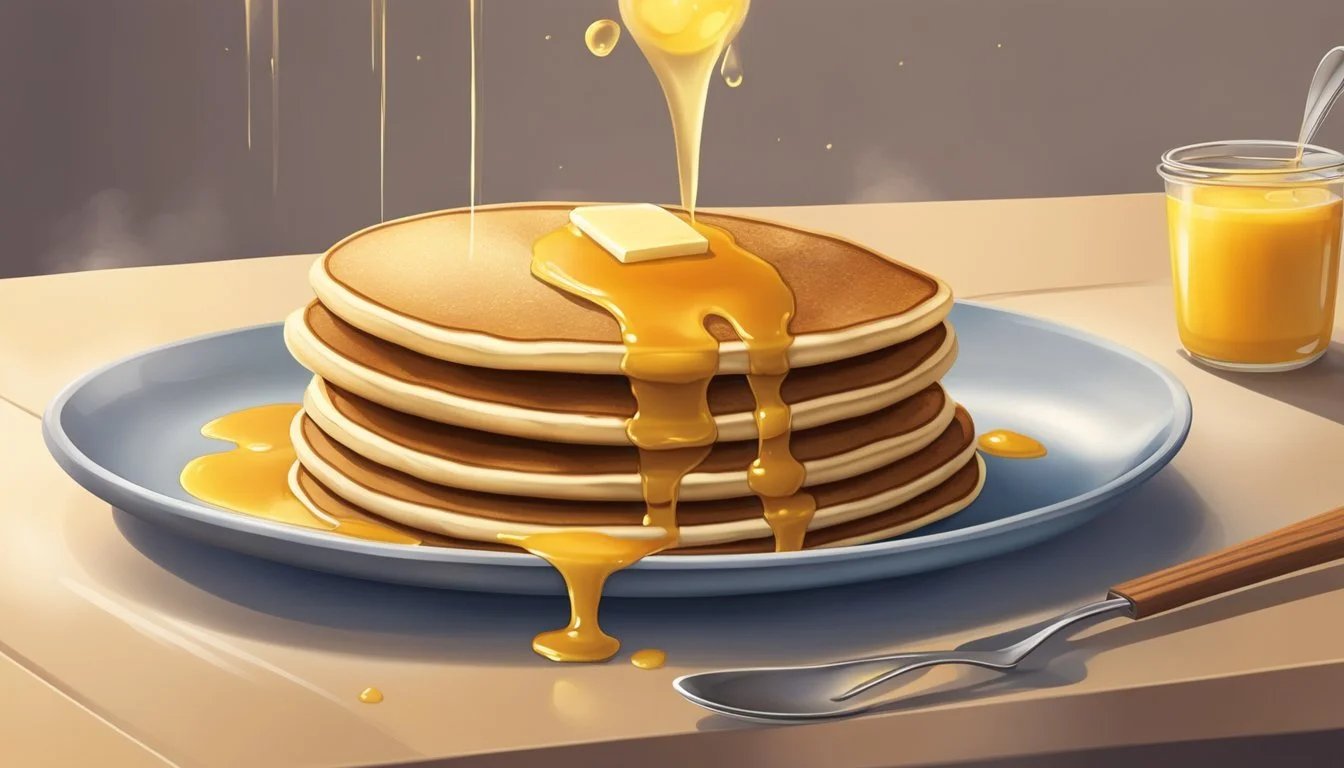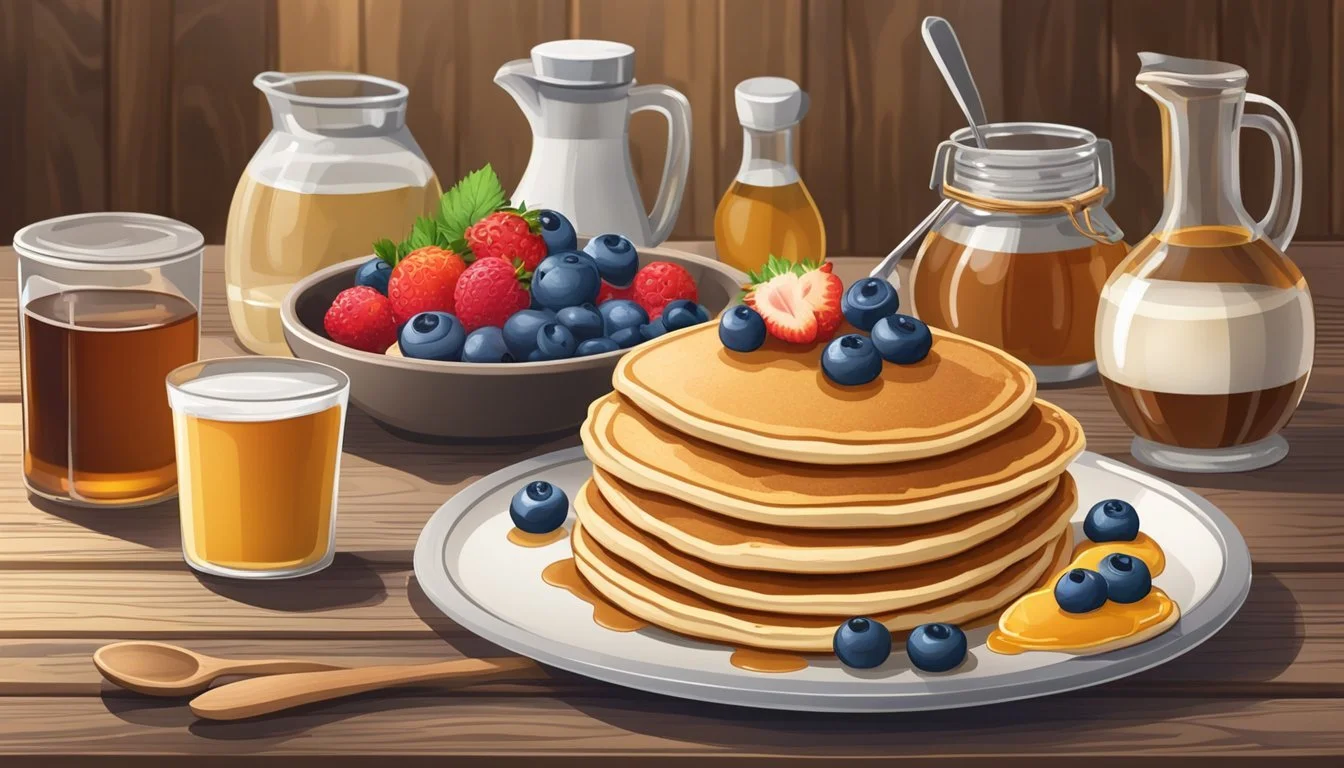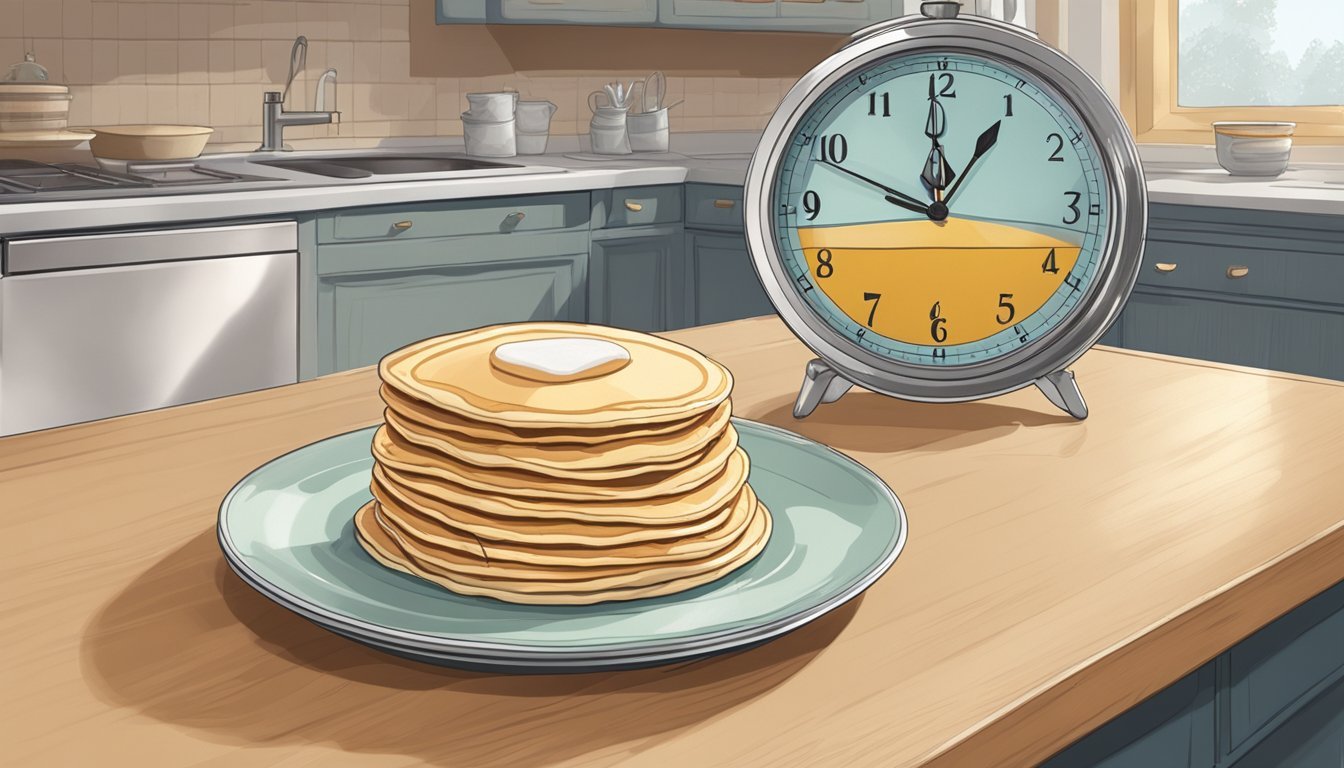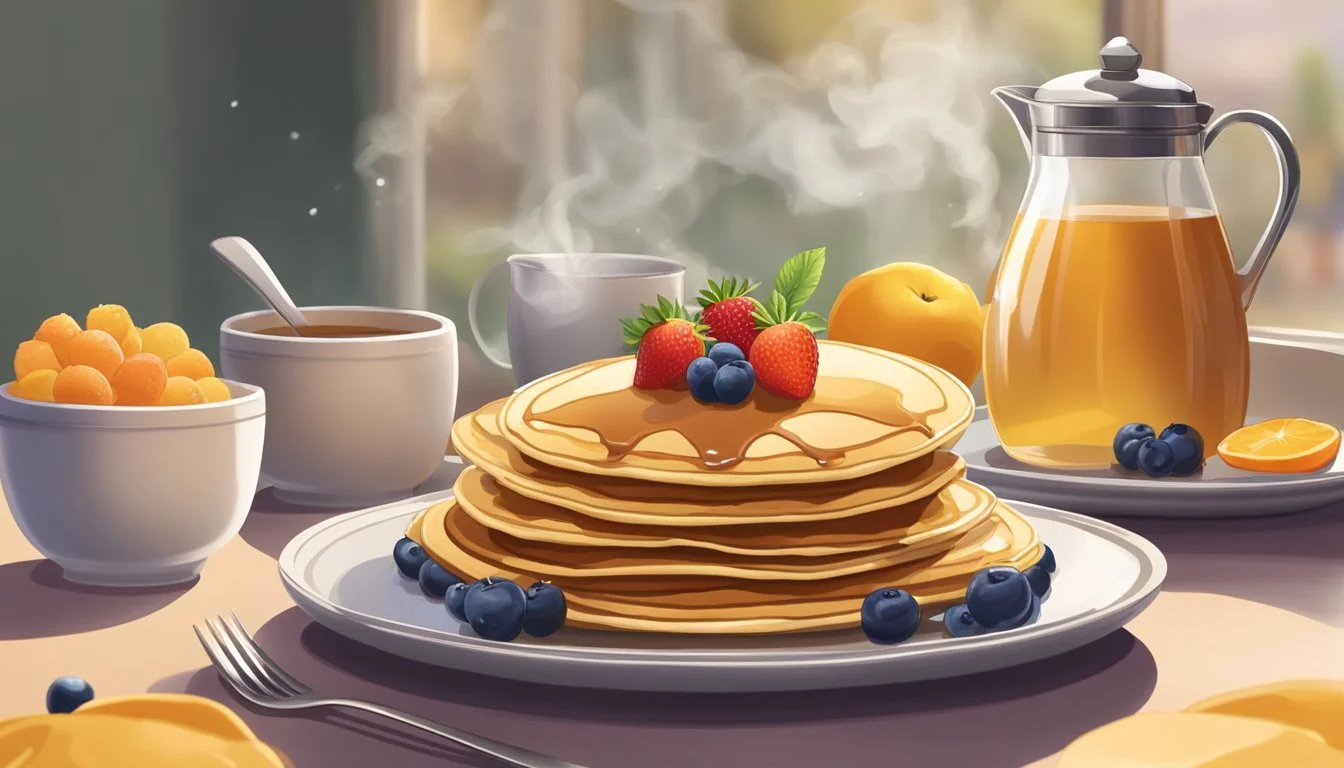How Long Do Freshly Prepared Pancakes Last?
Shelf Life and Storage Tips
Freshly prepared pancakes are a beloved breakfast food enjoyed by many for their warm, fluffy texture and versatility in pairing with a variety of toppings. Their popularity often has people making them in large batches to enjoy the experience more than once. To determine how long they can be savored after their initial preparation, a key factor is storage. When stored properly in the refrigerator, pancakes can typically remain fresh for consumption for up to 5-7 days. This time frame allows for the enjoyment of pancakes throughout the week without significant loss of taste or texture.
Proper storage involves keeping the pancakes in an air-tight container or resealable bag to prevent exposure to air and moisture. This not only helps maintain their freshness but also prevents the pancakes from absorbing any odors present in the refrigerator. It is important to note that the inclusion of fresh ingredients such as fruits may affect the longevity of the pancakes, potentially reducing their optimal shelf life in the fridge.
Furthermore, if the pancakes are not expected to be consumed within a week, freezing offers a longer-term solution. When frozen shortly after cooling down to room temperature, pancakes can be kept for up to two months. This method allows for preserving the quality of the pancakes, with reheating being a simple process that can restore them close to their freshly cooked state.
Fundamentals of Pancake Preservation
Proper storage methods and awareness of ingredient impact are essential for extending the freshness of pancakes.
Effects of Ingredients on Freshness
Different ingredients can influence the shelf life of pancakes. Milk, butter, and eggs are perishable and can cause pancakes to spoil faster. These wet ingredients introduce moisture, which is a breeding ground for bacteria. Pancakes made with fresh milk, butter, or eggs should ideally be consumed within 2-3 days when refrigerated.
Alternatively, ingredients such as oil, baking powder, and baking soda do not significantly affect the freshness lifespan of the finished product. However, the inclusion of fresh fruit or perishable mix-ins can reduce shelf life due to their moisture content and perishability.
Role of Air Exposure in Spoilage
The exposure to air can greatly accelerate the spoilage process due to oxidation and the growth of airborne bacteria. To combat this, one should store pancakes in an airtight container or a sealable bag to minimize air exposure. This helps to preserve their freshness and structure and prevents them from absorbing any odors present in the refrigerator.
Furthermore, pancakes should be allowed to cool completely before storage to prevent condensation within the container, as the added moisture can lead to a soggy texture and promote microbial growth. Pancakes separated with layers of parchment paper can prevent sticking and further maintain quality.
Storing Freshly Prepared Pancakes
Proper storage techniques for freshly prepared pancakes are crucial to maintain their texture and taste while minimizing food waste. The lifespan of pancakes can be extended significantly through refrigeration or freezing when kept in the proper containers.
Refrigeration Techniques
When refrigerating pancakes, they must be cooled down completely to prevent moisture build-up which can lead to sogginess. Stack pancakes with parchment paper or wax paper between each one to maintain their integrity and ease of separation. An airtight container or ziplock bag is essential; it not only preserves their freshness but also prevents them from absorbing any odors from the fridge. Typically, pancakes can last in the fridge for 2-7 days, depending on the ingredients used and the tightness of the seal.
Freezing Instructions
For longer storage, freezing is an optimal choice. To freeze pancakes:
Let them cool completely.
Place a layer of parchment paper between each pancake to prevent sticking.
Wrap the stack with plastic wrap or aluminum foil.
Place the wrapped stack in a freezer-safe bag or an airtight container before placing in the freezer.
Properly stored, pancakes can last in the freezer for up to two months. Labeling the bag or container with the date will help keep track of how long they have been stored.
Best Airtight Containers
Choosing the best airtight containers plays an essential role in the quality and shelf-life of stored pancakes. Options include:
Plastic Tupperware: Easy to find and comes in various sizes.
Glass containers with lids: They do not absorb odors or flavors.
Dedicated pancake holders: Specifically designed for pancake storage, if available.
Ziplock bags: These are space-saving and can be sealed tightly.
Utilize these storage solutions to ensure pancakes remain as fresh as possible for their anticipated shelf-life in the fridge or freezer.
Increasing Pancake Longevity
To ensure pancakes maintain their quality over time, proper storage methods must be employed, particularly when freezing them. Emphasis on moisture control is critical to prevent the texture from deteriorating.
Recommended Freezer Practices
When freezing pancakes, individuals should employ specific techniques to prevent freezer burn and preserve the pancakes' desirable qualities. It is advisable to:
Cool pancakes to room temperature to avoid condensation.
Place pancakes in a single layer on a baking sheet lined with parchment or wax paper.
Freeze the pancakes on the baking sheet until solid, which usually takes about 2 hours.
Transfer the frozen pancakes into a freezer-safe bag or container, removing as much air as possible.
Label the container with the date to ensure the pancakes are used while at their peak quality.
By following these steps, pancakes can typically last in the freezer for up to two months.
Moisture Control
Controlling moisture is paramount when storing pancakes in a refrigerator or freezer. Here are key points to consider:
Wrap pancakes tightly with plastic wrap or aluminum foil, or place in an airtight container to minimize exposure to air.
If using a container, it can be helpful to place a sheet of paper towel inside to absorb any excess moisture and prevent sogginess.
In the refrigerator, pancakes should generally be consumed within 2 to 3 days for optimal freshness.
By adhering to these moisture control methods, the shelf life of pancakes can be significantly extended while maintaining their texture and flavor.
Reheating and Serving
When reheating pancakes, one aims to restore the fresh-off-the-griddle warmth and texture. Effective reheating not only warms the pancakes but also preserves their soft interior and lightly crisp edges.
Optimizing Reheating Methods
There are multiple appliances suitable for reheating pancakes. Here are some of the best methods:
Microwave: It quickly reheats pancakes. For a single pancake, 15 to 30 seconds is usually sufficient, while 4 to 5 pancakes may require up to 60 seconds. For frozen pancakes, additional time is needed.
Oven: To maintain the texture, preheat your oven to 350°F and arrange the pancakes in a single layer on a baking sheet. Reheating usually takes 5 to 10 minutes. Covering with foil can prevent them from drying out.
Toaster Oven: For a crispier edge, placing a pancake in each toaster slot and setting it to a high level can achieve a nicely textured finish. Adjust the level depending on your toaster's settings and the desired crispness.
Stovetop: Reheating pancakes on a skillet over medium heat can also retain flavor and texture. This method can give the pancakes a slightly crisp edge and a warm center.
Maintaining Texture and Flavor
Reheating should aim not only to warm the pancakes but also to retain their original quality:
Microwave Tips: To keep pancakes moist, cover them with a damp paper towel while reheating.
Oven Advice: Optionally, brush the tops with melted butter before heating to add flavor and a soft sheen.
Avoiding Sogginess: Regardless of the method, one should avoid over-reheating as it can lead to tough or rubbery pancakes.
By choosing the right method and being mindful of reheating time, one can enjoy leftover pancakes that are nearly as good as when they were first made.
Shelf Life and Spoilage Indicators
When storing freshly prepared pancakes, their duration of freshness can vary greatly depending on storage methods. Properly preserved pancakes can maintain their quality, while the presence of spoilage indicators can alert consumers to potential foodborne illness risks.
Refrigerator vs. Freezer Shelf Life
Refrigerator:
Freshly prepared pancakes can last 1-2 days in the refrigerator.
Seal in an air-tight container to maximize freshness.
Freezer:
For longer storage, pancakes can be frozen, extending their shelf life to up to 3 months.
Store in a freezer-safe bag or container, separating layers with parchment paper to prevent sticking.
Detecting Spoilage
Consumers should be aware of spoilage signs to prevent the risk of consuming spoiled food. Indicators of pancake spoilage include:
Mold: Visible spots or fuzzy growths, often green or black, indicate mold presence.
Odor: A sour or off-smell is a clear sign that pancakes should not be consumed.
Texture: If pancakes become excessively moist or slimy, they may be contaminated with bacteria and are unsafe to eat.
Discarding pancakes at any sign of spoilage is critical to prevent foodborne illnesses. It is always safer to err on the side of caution with respect to food expiration.
Preparing and Cooking Pancakes
When preparing pancakes, one can either opt for homemade recipes or store-bought mixes, each with its unique advantages. Precision in following the recipe or mix instructions and proper cooking techniques will influence pancake quality and serve as fundamental steps before considering storage time.
Homemade vs. Store-Bought Mixes
Homemade Pancake Mix:
Ingredients: Typically requires basic ingredients such as flour, eggs, milk, baking powder, and salt.
Customization: Allows for adjustments in ingredients to cater to dietary preferences and creative shapes and sizes.
Taste: May offer a fresher and more authentic flavor based on the quality of ingredients used.
Store-Bought Pancake Mix:
Convenience: Just add water or a few wet ingredients; ideal for time-saving without the need for full ingredient lists.
Consistency: Pre-measured and mixed for uniformity, resulting in consistent texture and flavor.
Variety: Available in several types, from buttermilk to whole grain, catering to diverse tastes and dietary needs.
Cooking Methods and Appliances
Cooking Batter on a Griddle:
Heat Distribution: Griddles provide even heat distribution, critical for cooking pancakes uniformly.
Space: Larger surface area allows for multiple pancakes to be cooked simultaneously.
Cooking with a Non-Stick Frying Pan:
Convenience: Non-stick pans are widely available and require less oil for cooking, reducing calorie count.
Control: Easier to manage heat on a stove-top, allowing for adjustment to prevent burning.
Whether one uses a griddle or frying pan, it is essential that the cooking appliance is properly heated before adding the pancake batter to achieve golden and tender pancakes with a slight crispiness on the edges. Pancakes should be cooked until bubbles form on the surface and the edges are slightly dry, then flipped and cooked until golden brown.
Creative Serving Options
When it comes to enhancing the enjoyment of pancakes, creative serving options can elevate the humble pancake from a simple dish to an exciting meal, suitable for both breakfast and dinner.
Sweet and Savory Toppings
One can easily transform pancakes into a decadent treat or a hearty meal by choosing the right toppings.
For a sweeter experience:
Fruits: A colorful assortment of fruits such as sliced strawberries, blueberries, or bananas adds a natural sweetness and a vibrant look.
Syrups: Traditional maple syrup is a classic, but experimenting with flavored syrups like blueberry or caramel can offer a delightful twist.
Additional sweeteners: Adding chocolate chips or a dollop of whipped cream can turn pancakes into a dessert-like indulgence.
For a savory twist:
Cheese: Incorporate shredded cheese into or on top of pancakes for a savory kick.
Bacon or Ham: Pieces of crispy bacon or chopped ham can be mixed into the batter or used as a topping for a satisfying meal.
Innovative Pancake Shapes and Sizes
The visual appeal of pancakes is nearly as important as their taste, and experimenting with shapes and sizes can make the dish more engaging.
Mini Pancakes: Bite-sized pancakes, also known as silver dollars, are perfect for dipping and can be served as appetizers or snacks.
Pancake Art: Using squeeze bottles, one can create intricate designs or characters for a fun breakfast that is sure to impress children and adults alike.
Thick and Fluffy or Thin and Crispy: Varying the thickness of the batter before cooking can yield either thick, fluffy pancakes or thin, crispy ones, catering to individual texture preferences.
Best Practices for Handling Leftovers
When dealing with leftover pancakes, food safety and quality are the primary concerns. Pancakes should be stored promptly after cooling at room temperature. Improper handling can lead to food-borne illnesses.
For cooked pancakes, the following steps should ensure optimal freshness:
Allow pancakes to cool to room temperature to prevent the growth of bacteria.
Place them in an airtight container or wrap tightly with cling film or aluminum foil.
Refrigerate within 2 hours of cooking; they can last for up to 2-3 days.
For longer storage, freeze pancakes by placing them on a baking sheet in a single layer until frozen, then transfer to a freezer-safe bag or container, label with the date, and store for up to 2-3 months.
When it comes to pancake batter, meal preppers might wonder about its shelf life. To store pancake batter:
Keep the batter in an airtight container.
Refrigerate and use within 1-2 days.
For reheating, options include the oven, toaster, or microwave. Each method can revive the pancakes' desirable texture and warmth:
Oven: Preheat to 350°F, lay out the pancakes in a single layer on a baking sheet, and heat for about 10 minutes.
Toaster: Pop the pancakes in for a quick warm-up, being cautious not to over-toast.
Microwave: Short bursts of heating prevent them from becoming too rubbery.
Do not neglect leftovers; treat them with the same care as the original meal. Proper storage is a straightforward way to ensure meal prep efficiency while maintaining quality and safety.
Nutritional Considerations
When considering the nutritional aspects of pancakes, one should be aware of the diversity in ingredients and preparation methods that affect their healthfulness. This section explores varieties of pancakes with an emphasis on nutritional value and allergy-friendly options.
Healthier Pancake Variants
For those aiming to improve the nutritional profile of their pancakes, whole wheat pancakes serve as a healthier variant over the traditional recipes that commonly use refined flour. Whole wheat pancakes contain more fiber and nutrients than their white flour counterparts. Adding toppings such as fresh fruit or a dab of natural peanut butter can also increase the nutrient content while providing natural sweetness.
Key Ingredients for Healthier Pancakes:
Whole wheat flour or alternative grain flours
Oats or oat flour for added fiber
Almond milk or low-fat dairy options
Natural sweeteners such as honey or maple syrup
Allergy-Friendly Alternatives
For individuals with dietary restrictions, there are various allergy-friendly alternatives that can be used to make homemade pancakes. Gluten-free flours like buckwheat or almond flour are excellent choices for those with gluten intolerance or celiac disease. Similarly, dairy-free and egg-free preparations cater to those with allergies to dairy or eggs.
Allergy-Friendly Pancake Ingredients:
Gluten-free flours: buckwheat, almond, or coconut flour
Dairy-free milks: almond, soy, or oat milk
Egg substitutes: applesauce, banana, or commercial egg replacers
Both healthier and allergy-friendly pancake variants provide options for those looking to enjoy pancakes while adhering to specific nutritional requirements or allergen restrictions. The choice of ingredients not only affects the overall healthfulness but also the taste and texture of the final product.
Advanced Meal Prepping Techniques
Meal prepping pancakes is a fantastic way for a pancake lover to ensure a quick, delicious breakfast every morning. By focusing on efficient batch cooking and proper storage methods, one can enjoy pancakes that taste freshly made even on the busiest of days.
Batch Cooking and Storage
He or she should commence by preparing a large batch of pancakes to save time and resources. Freezing pancakes is an effective method to preserve their freshness, and it begins with letting them cool completely after cooking. They should be placed in a single layer on a baking sheet, ensuring they are not touching, to freeze initially. Once solidly frozen, the pancakes can be transferred to airtight containers or freezer-safe bags, separated by parchment paper to prevent sticking.
Freezing Steps Description 1. Cool Completely Allow pancakes to reach room temperature after cooking. 2. Initial Freeze Lay on a baking sheet in the freezer until firm. 3. Airtight Storage Store in freezer bags with parchment paper. 4. Label & Date Mark with the freezing date for proper rotation.
Quick Breakfast Solutions
For individuals seeking a quick breakfast, reheating frozen pancakes simplifies the morning routine. Pancakes can be heated in an oven preheated to 350°F (175°C) on a baking sheet for approximately 10 minutes. Alternatively, a toaster set to a low or medium setting will provide warm, lightly crisped pancakes in a matter of minutes. These methods ensure that even after freezing, the pancakes retain the desired taste and texture.
Oven Method: Heats multiples at once, maintains softness
Toaster Method: Quick, adds crispiness
By using these advanced meal prepping techniques, one can store pancakes efficiently and reheat them quickly, making it possible to relish in a satisfying breakfast every day.









